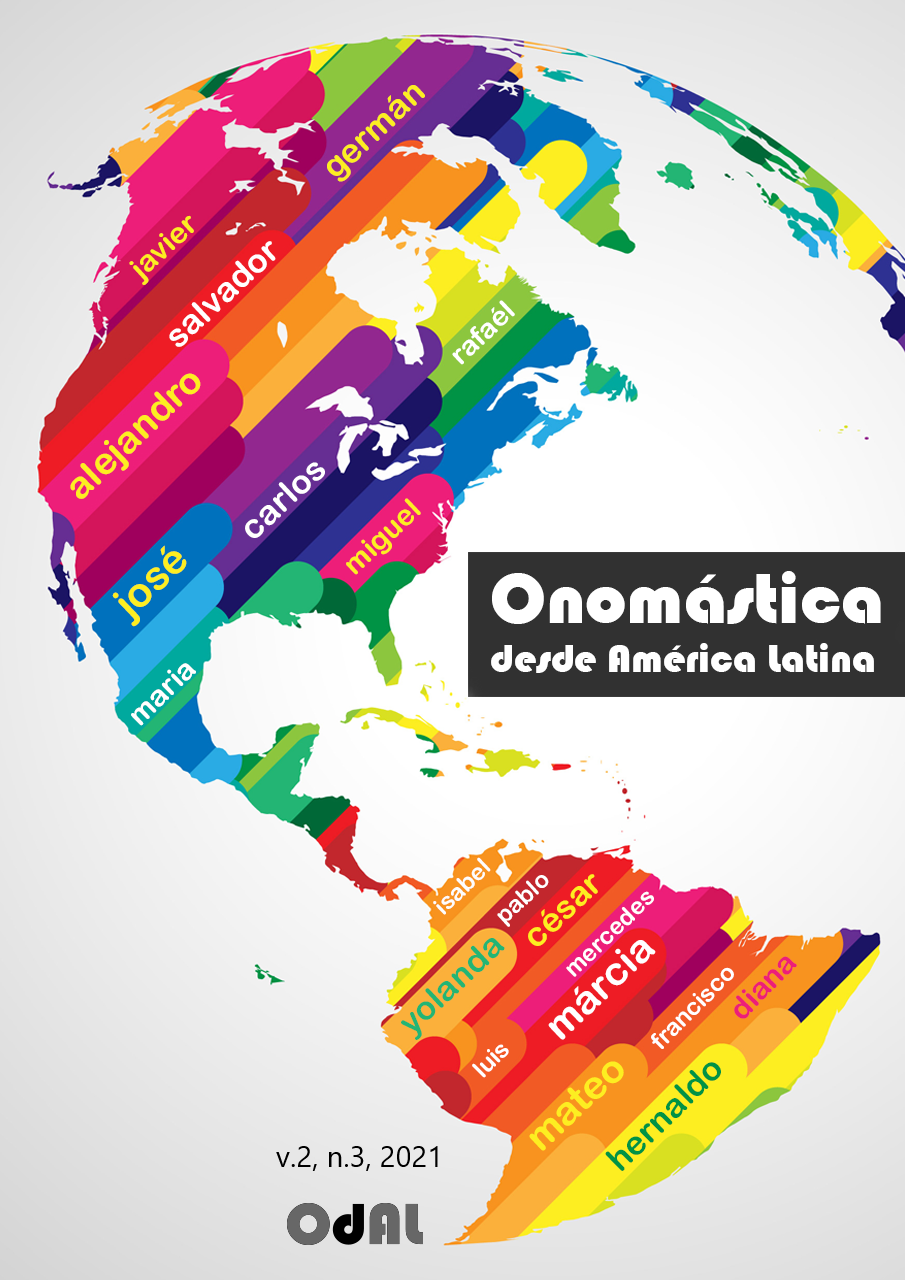Tendencias religiosas en la antroponimia rondonense -TRAD-
DOI:
https://doi.org/10.48075/odal.v2i3.26603Palavras-chave:
Socioanthroponomics, Religious motivation, Juxtaposed namesResumo
Es de sabiduría popular que atribuir nombres religiosos a los hijos puede significar devoción a un Santo, personaje bíblico o creencia religiosa particular de una determinada comunidad. Sin embargo, al saber de hecho las motivaciones reales para elegir un determinado antropónimo, a partir de entrevistas con los padres o con los propios portadores del nombre propio, se observa que los nombres religiosos pueden evidenciar cuestiones más allá de la simple devoción. En ese sentido, el objetivo de este artículo es analizar, a partir de los estudios de la socioantroponomástica, qué factores influencian en la práctica de nombrar a un hijo con el modelo de atribución denominado religión (JIMÉNEZ SEGURA, 2014). Para ello, la investigación emplea un corpus formado por 250 nombres yuxtapuestos colectados a partir de entrevistas semiestructuradas, en un lapso que abarca 1930-1940 a 2010, en la ciudad de Marechal Cândido Rondon, Brasil. La investigación apunta que atribuir nombres religiosos puede formar parte de un ideario de una determinada comunidad, ya sea como nominación de un hijo, a través de un nombre bíblico, puede mostrar cuestiones identitarias más allá del significado restringido del nombre (SEIDE, 2016).
Referências
Deitos, N. J. (2007). A igreja católica no Oeste do Paraná e sua atuação no processo de colonização. Migrações e a construção do Oeste do Paraná: século XXI em perspectiva. Cascavel: Coluna do Saber. 183-189.
Dick, M. V. de P. do A. (1992) Toponímia e Antroponímia no Brasil. São Paulo: Coletânea de Estudos. FFLCH.
Guérios, R. F. M. (1981). Dicionário etimológico de nomes e sobrenomes. São Paulo: Ave Maria.
Hall, S. (1992). A Identidade Cultural na pós-modernidade. Rio de Janeiro: DP&.
Jiménez Segura, S. (2016) Los modelos de atribuición del nombre de pila tradicional y a partir de la moda en el municipio de Tlalnepantla de Baz, estado de México. Estudio sincrónico y diacrónico de tres calas: 1930, 1960 y 1990. (Dissertação de Mestrado), Escuela Nacional de Antropología e Historia.
López Franco. Y. G. (2014). Los nombres de pila en la década de 1980 en Montpellier, Francia, y en Tlalnepantla de Baz, México, bajo un enfoque socioantroponímico. In. Isquerdo, A.N.; Dal Corno, G.O.M, As ciências do léxico. Lexicologia, lexicografia, terminologia, Campo Grande: Ed. UFMS.
Pensin, T.G. (2020). Uma revisão ao perfil nomeador dos habitantes de Toledo, Paraná:tradicional ou inovador? Onomástica desde América Latina, n.1, v.1. 199-221.
Saatkamp, V. (1985). Desafios Lutas e Conquistas: História de Marechal Cândido Rondon. Cascavel: Assoeste.
Seide, M. S. (2016). A identidade religiosa na antroponímia de Marechal Cândido Rondon.
Revista Relin, v. 24, n. 1. 167-186.
Seide, M. S. (2018). Moda e tradição na antroponímia. A.N.; Dal Corno, G.O.M, As ciências do léxico. Lexicologia, lexicografia, terminologia Campo Grande: Ed. UFMS. 161 – 178.
Seide, M. S. (2020a). A Antroponomástica Comparada. Onomástica desde América Latina, n.2, v.1. 83-102 https://doi.org/10.48075/odal.v1i2.25488
Seide, M. S. (2020b). Antroponimia, diáspora y migración: los descendientes de lituanos en Brasil. Onomástica desde América Latina, n.1, v.1. 100-121 https://doi.org/10.48075/odal.v1i1.24156
Van Langendonck, W. (2007). Theory and Typology of Proper Names. Berlin/New York: Mouton de Gruyter.
Downloads
Publicado
Como Citar
Edição
Seção
Licença
Copyright (c) 2020 Onomástica desde América Latina

Este trabalho está licenciado sob uma licença Creative Commons Attribution-NonCommercial-ShareAlike 4.0 International License.
Aviso de Direito Autoral Creative Commons
Política para Periódicos de Acesso Livre
Autores que publicam nesta revista concordam com os seguintes termos:
1. Autores mantém os direitos autorais e concedem à revista o direito de primeira publicação, com o trabalho simultaneamente licenciado sob a Licença Creative Commons Attribution que permite o compartilhamento do trabalho com reconhecimento da autoria e publicação inicial nesta revista.
2. Autores têm autorização para assumir contratos adicionais separadamente, para distribuição não-exclusiva da versão do trabalho publicada nesta revista (ex.: publicar em repositório institucional ou como capítulo de livro), com reconhecimento de autoria e publicação inicial nesta revista.
3. Autores têm permissão e são estimulados a publicar e distribuir seu trabalho online (ex.: em repositórios institucionais ou na sua página pessoal) a qualquer ponto antes ou durante o processo editorial, já que isso pode gerar alterações produtivas, bem como aumentar o impacto e a citação do trabalho publicado (Veja O Efeito do Acesso Livre).
Licença Creative Commons
Esta obra está licenciada com uma Licença Creative Commons Atribuição-NãoComercial-CompartilhaIgual 4.0 Internacional, o que permite compartilhar, copiar, distribuir, exibir, reproduzir, a totalidade ou partes desde que não tenha objetivo comercial e sejam citados os autores e a fonte.

